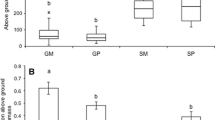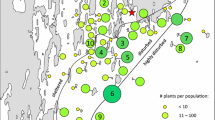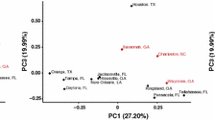Abstract
Intraspecific plant trait variation can have cascading effects on plant-associated biotic communities. Sexual dimorphism is an important axis of genetic variation in dioecious plants, but the strength of such effects and the underlying mechanisms relative to genetic variation are unknown. We established a common garden with 39 genotypes of Baccharis salicifolia sampled from a single population that included male and female genotypes and measured plant traits and quantified associated arthropod communities. Genetic variation sensu lato (genotypic variation) had strong effects on most plant traits (flower number, relative growth rate, specific leaf area, percent water content, carbon–nitrogen ratio, monoterpene but not sesquiterpene concentrations) and on herbivore and predator density, and on arthropod community composition (relative abundance of 14 orders). In contrast, sexual dimorphism had weaker effects on only a few plant traits (flower number and relative growth rate), on predator density, and on arthropod community composition, but had no effect on herbivore density. Variation in flower number drove genetic variation sensu lato and sex dimorphism in predator density and arthropod community composition. There was unique genetic variation sensu lato in herbivore density (positively) associated with monoterpene concentration and in arthropod community composition associated with specific leaf area and carbon–nitrogen ratio. There was unique sexual dimorphism in arthropod community composition associated with plant relative growth rate. Together, these results demonstrate that genetic variation sensu lato and sexual dimorphism can shape plant-associated arthropod communities via both parallel and unique mechanisms, with greater overall effects of the former.




Similar content being viewed by others
References
Abdala-Roberts L, Pratt JD, Pratt R et al (2016) Multi-trophic consequences of plant genetic variation in sex and growth. Ecology 97:743–753
Abdala-Roberts L, Pratt R, Pratt JD, Mooney KA (2017) Traits underlying community consequences of plant intra-specific diversity. PLoS One 12:e0183493. https://doi.org/10.1371/journal.pone.0183493
Agrawal AA (2011) Current trends in the evolutionary ecology of plant defense. Funct Ecol 25:420–432. https://doi.org/10.1111/j.1365-2435.2010.01796.x
Agrawal AA, Fishbein M (2006) Plant defense syndromes. Ecology 87:S132–S166
Ågren J, Danell K, Elmqvist T et al (1999) Sexual dimorphism and biotic interactions. Gender and sexual dimorphism in flowering plants. Springer, Heidelberg, pp 217–246
Anstett DN, Ahern JR, Glinos J et al (2015) Can genetically based clines in plant defence explain greater herbivory at higher latitudes? Ecol Lett 18:1376–1386. https://doi.org/10.1111/ele.12532
Ashman T-L, King EA (2005) Are flower-visiting ants mutualists or antagonists? A study in a gynodioecious wild strawberry. Am J Bot 92:891–895. https://doi.org/10.3732/ajb.92.5.891
Bailey JK, Wooley SC, Lindroth RL, Whitham TG (2006) Importance of species interactions to community heritability: a genetic basis to trophic-level interactions. Ecol Lett 9:78–85. https://doi.org/10.1111/j.1461-0248.2005.00844.x
Bailey JK, Schweitzer JA, Úbeda F et al (2009) From genes to ecosystems: a synthesis of the effects of plant genetic factors across levels of organization. Philos Trans R Soc Lond B Biol Sci 364:1607–1616. https://doi.org/10.1098/rstb.2008.0336
Bates D, Mächler M, Bolker B, Walker S (2014) Fitting linear mixed-effects models using lme4. arXiv:14065823 [stat]
Bickerton MW, Hamilton GC (2012) Effects of intercropping with flowering plants on predation of Ostrinia nubilalis (Lepidoptera: Crambidae) eggs by generalist predators in bell peppers. Environ Entomol 41:612–620. https://doi.org/10.1603/en11249
Boecklen WJ, Price PW, Mopper S (1990) Sex and drugs and herbivores: sex-biased herbivory in arroyo willow (Salix Lasiolepis). Ecology 71:581–588. https://doi.org/10.2307/1940311
Cepeda-Cornejo V, Dirzo R (2010) Sex-related differences in reproductive allocation, growth, defense and herbivory in three dioecious Neotropical palms. PLoS One 5:e9824. https://doi.org/10.1371/journal.pone.0009824
Coley PD, Bryant JP, Chapin FS (1985) Resource availability and plant antiherbivore defense. Science 230:895–899. https://doi.org/10.1126/science.230.4728.895
Cornelissen T, Stiling P (2005) Sex-biased herbivory: a meta-analysis of the effects of gender on plant-herbivore interactions. Oikos 111:488–500. https://doi.org/10.1111/j.1600-0706.2005.14075.x
Cox PA (1982) Vertebrate pollination and the maintenance of dioecism in Freycinetia. Am Nat 120:65–80. https://doi.org/10.1086/283970
Crutsinger GM (2016) A community genetics perspective: opportunities for the coming decade. New Phytol 210:65–70. https://doi.org/10.1111/nph.13537
Delph L (1999) Sexual dimorphism in life history. Gender and sexual dimorphism in flowering plants. Springer, Heidelberg, pp 149–173
Dungey HS, Potts BM, Whitham TG, Li H-F (2000) Plant genetics affects arthropod community richness and composition: evidence from a synthetic eucalypt hybrid population. Evolution 54:1938–1946. doi:10.1554/0014-3820(2000)054[1938:pgaacr]2.0.co;2
Hambäck PA, Inouye BD, Andersson P, Underwood N (2014) Effects of plant neighborhoods on plant–herbivore interactions: resource dilution and associational effects. Ecology 95:1370–1383. https://doi.org/10.1890/13-0793.1
Johnson MTJ, Agrawal AA (2005) Plant genotype and environment interact to shape a diverse arthropod community on evening primrose (Oenothera biennis). Ecology 86:874–885. https://doi.org/10.1890/04-1068
Kabir MF, Moritz KK, Stenberg JA (2014) Plant-sex-biased tritrophic interactions on dioecious willow. Ecosphere 5:1–9. https://doi.org/10.1890/es14-00356.1
Kessler A, Baldwin IT (2001) Defensive function of herbivore-iInduced plant volatile emissions in nature. Science 291:2141–2144. https://doi.org/10.1126/science.291.5511.2141
Kessler A, Heil M (2011) The multiple faces of indirect defences and their agents of natural selection. Funct Ecol 25:348–357. https://doi.org/10.1111/j.1365-2435.2010.01818.x
Legendre P, Anderson MJ (1999) Distance-based redundancy analysis: testing multispecies responses in multifactorial ecological experiments. Ecol Monogr 69:1–24. doi:10.1890/0012-9615(1999)069[0001:dbratm]2.0.co;2
Lenth RV (2016) Least-squares means: the R package lsmeans. J Stat Soft 69:1–33. https://doi.org/10.18637/jss.v069.i01
Letourneau DK, Armbrecht I, Rivera BS et al (2011) Does plant diversity benefit agroecosystems? A synthetic review. Ecol Appl 21:9–21. https://doi.org/10.1890/09-2026.1
Lloyd DG, Webb CJ (1977) Secondary sex characters in plants. Bot Rev 43:177–216
Loayza I, Abujder D, Aranda R et al (1995) Essential oils of Baccharis salicifolia, B. latifolia and B. dracunculifolia. Phytochemistry 38:381–389. https://doi.org/10.1016/0031-9422(94)00628-7
Marquis RJ, Whelan C (1996) Plant morphology and recruitment of the third trophic level: subtle and little-recognized defenses? Oikos 75:330–334. https://doi.org/10.2307/3546260
McArdle BH, Anderson MJ (2001) Fitting multivariate models to community data: a comment on distance-based redundancy analysis. Ecology 82:290–297. doi:10.1890/0012-9658(2001)082[0290:fmmtcd]2.0.co;2
Ming R, Bendahmane A, Renner SS (2011) Sex chromosomes in land plants. Ann Rev Plant Biol 62:485–514. https://doi.org/10.1146/annurev-arplant-042110-103914
Mooney KA, Fremgen A, Petry WK (2012a) Plant sex and induced responses independently influence herbivore performance, natural enemies and aphid-tending ants. Arthropod Plant Interact 6:553–560. https://doi.org/10.1007/s11829-012-9204-5
Mooney KA, Pratt RT, Singer MS (2012b) The Tri-trophic Interactions Hypothesis: interactive effects of host plant quality, diet breadth and natural enemies on herbivores. PLoS One 7:e34403. https://doi.org/10.1371/journal.pone.0034403
Moreira X, Mooney KA (2013) Influence of plant genetic diversity on interactions between higher trophic levels. Biol Lett 9:20130133. https://doi.org/10.1098/rsbl.2013.0133
Moreira X, Nell CS, Katsanis A et al (2016) Herbivore specificity and the chemical basis of plant–plant communication in Baccharis salicifolia (Asteraceae). New Phytol. https://doi.org/10.1111/nph.14164
Nichols-Orians CM, Fritz RS, Clausen TP (1993) The genetic basis for variation in the concentration of phenolic glycosides in Salix sericea: clonal variation and sex-based differences. Biochem Syst Ecol 21:535–542. https://doi.org/10.1016/0305-1978(93)90052-s
Oksanen J, Blanchet G, Christensen MR, et al (2016) vegan: community ecology package. R package version 2.4-1
Pacini E, Nepi M (2007) Nectar production and presentation. Nectaries and Nectar. Springer, Dordrecht, pp 167–214
Petry WK, Perry KI, Fremgen A et al (2013) Mechanisms underlying plant sexual dimorphism in multi-trophic arthropod communities. Ecology 94:2055–2065. https://doi.org/10.1890/12-2170.1
Pratt JD, Mooney KA (2013) Clinal adaptation and adaptive plasticity in Artemisia californica: implications for the response of a foundation species to predicted climate change. Glob Change Biol 19:2454–2466. https://doi.org/10.1111/gcb.12199
Pratt JD, Keefover-Ring K, Liu LY, Mooney KA (2014) Genetically based latitudinal variation in Artemisia californica secondary chemistry. Oikos 123:953–963. https://doi.org/10.1111/oik.01156
Pratt JD, Datu A, Tran T et al (2017) Genetically based latitudinal clines in Artemisia californica drive parallel clines in arthropod communities. Ecology 98:79–91. https://doi.org/10.1002/ecy.1620
R Core Team (2015) R: A language and environment for statistical computing. R Foundation for Statistical Computing, Vienna
Rasband WS (2008) ImageJ, US National Institutes of Health, Bethesda, Maryland, USA. http://imagej.nih.gov/ij/
Rausher MD (1992) The measurement of selection on quantitative traits: biases due to environmental covariances between traits and fitness. Evolution 46:616–626. https://doi.org/10.1111/j.1558-5646.1992.tb02070.x
Roccaforte K, Russo SE, Pilson D (2015) Hybridization and reproductive isolation between diploid Erythronium mesochoreum and its tetraploid congener E. albidum (Liliaceae). Evolution 69:1375–1389. https://doi.org/10.1111/evo.12666
Singmann H, Bolker B, Westfall J, Aust F (2015) afex: analysis of factorial experiments. R package version 013–145
Tack AJM, Ovaskainen O, Pulkkinen P, Roslin T (2010) Spatial location dominates over host plant genotype in structuring an herbivore community. Ecology 91:2660–2672. https://doi.org/10.1890/09-1027.1
Tack AJM, Johnson MTJ, Roslin T (2012) Sizing up community genetics: it’s a matter of scale. Oikos 121:481–488. https://doi.org/10.1111/j.1600-0706.2011.19926.x
Venables WN, Ripley BD (2002) Modern applied statistics with S. Springer, New York
Wäckers FL, van Rijn PCJ, Bruin J (2005) Suitability of (extra-) floral nectar, pollen, and honeydew as insect food sources. In: Wäckers FL, van Rijn PCJ, Bruin J (eds) Plant-provided food for carnivorous insects: a protective mutualism and its applications. Cambridge University Press, Cambridge, pp 17–74
Whitham TG, Bailey JK, Schweitzer JA et al (2006) A framework for community and ecosystem genetics: from genes to ecosystems. Nat Rev Genet 7:510–523. https://doi.org/10.1038/nrg1877
Wimp GM, Whitham TG (2001) Biodiversity consequences of predation and host plant hybridization on an aphid–ant mutualism. Ecology 82:440–452. doi:10.1890/0012-9658(2001)082[0440:bcopah]2.0.co;2
Wimp GM, Young WP, Woolbright SA et al (2004) Conserving plant genetic diversity for dependent animal communities. Ecol Lett 7:776–780. https://doi.org/10.1111/j.1461-0248.2004.00635.x
Zunino MP, Novillo-Newton M, Maestri DM, Zygadlo JA (1997) Composition of the essential oil of Baccharis crispa Spreng. and Baccharis salicifolia Pers. grown in Córdoba (Argentina). Flavour Frag J 12:405–407. doi:10.1002/(sici)1099-1026(199711/12)12:6<405::aid-ffj667>3.0.co;2-r
Zytynska SE, Fay MF, Penney D, Preziosi RF (2011) Genetic variation in a tropical tree species influences the associated epiphytic plant and invertebrate communities in a complex forest ecosystem. Philos Trans R Soc B Biol Sci 366:1329–1336. https://doi.org/10.1098/rstb.2010.0183
Acknowledgements
This work was supported by NSF-DEB-1354734. CSN, JRC, and ASN were supported by the National Science Foundation Graduate Research Fellowship (under Grant no. DGE-1321846). MML was supported by a Ford Foundation Postdoctoral Fellowship.
Author information
Authors and Affiliations
Contributions
KM conceived and designed the experiment. KM, XM, and JP performed the experiment. CN analyzed the data. MML, JC, CN, AN, and KM wrote the manuscript.
Corresponding author
Ethics declarations
Conflict of interest
The authors declare that they have no conflicts of interest.
Additional information
Communicated by Colin Mark Orians.
Rights and permissions
About this article
Cite this article
Nell, C.S., Meza-Lopez, M.M., Croy, J.R. et al. Relative effects of genetic variation sensu lato and sexual dimorphism on plant traits and associated arthropod communities. Oecologia 187, 389–400 (2018). https://doi.org/10.1007/s00442-018-4065-y
Received:
Accepted:
Published:
Issue Date:
DOI: https://doi.org/10.1007/s00442-018-4065-y




